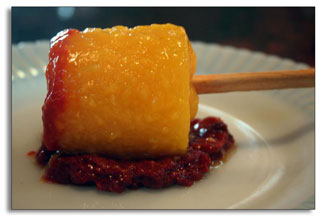|
|
The real chamoyby Ari LeVaux Even the name is still up for debate; it’s often spelled mangonada, and my spelling, in fact, appears to be the lesser-used choice. But I find mangoneada lyrically superior. It’s is a play on a conjugation of the verb mangonear, which means “to boss around.” I’ve heard mangoneada translated variously as meaning twisting an arm, extortion and bullying. Google Translate can’t seem to crack mangonear’s past participle conjugation, but in this sentence from a Spanish blog enough context comes through to support these interpretations: “...the economy is like a whore that is mangoneada by bankers with permission from the politicians.”
In addition to mango, Beltran also makes them with other fruits, like strawberry and watermelon. Strawberry is her favorite, she says. “It makes a real syrupy flavor.” Before speaking to Beltran, I had never heard of mangoneadas made from anything other than mango. But as I write, the Twitter feed that I have set up to monitor tweets containing the word “mangoneada” has just picked up the following: “...una mangoneada de fresa quieremoos!” This translates, loosely, as “we want a strawberry mangoneada.” If not for the chamoy component, mangoneadas could be made with household ingredients available at any grocery store. But the chamoy is not to be skipped if the treat is to be called a mangoneada. The pickled, fruit-based sauce is the mortar that binds the mangoneada’s disparate flavors together. And interestingly it contains a similar array of sweet spicy, sour and salty flavors, like a microcosm of the mangoneada itself. The magic those four flavors can create is well-known in cooking circles. Many Asian cuisines make a point of balancing those four flavors in every dish. Beyond sharing those four flavors, there are other Asian connections for chamoy. Historical evidence suggests the use of pickled fruit in chamoy was inspired by Japanese umeboshi, or pickled salty plums. Chamoy has also been linked to a Chinese candied sour salty plum called see mui. As is true with mangoneadas themselves, there are many ways to make chamoy. It can also be purchased at Mexican grocery stores, though most store-bought chamoy is not made with real fruit. Trechas brand, for example, is made from water, iodized salt, red peppers, citric acid, corn starch, sugar, xanthan gum, sodium benzoate and Red No. 40. You should never resort to using store bought chamoy, no matter how desperate you are for a mangoneada. It’s a simple matter to quickly fake some chamoy at home in a way that isn’t pickled, but still tastes much better than store-bought stuff. To make this “cheater’s chamoy,” wash and pit a dozen good-sized apricots, put them in a pot with water enough to cover, and boil for 20 minutes. Let them cool to room temperature, then blend with a cup of the cooking water, three tablespoons chile powder, a quarter cup of vinegar, and a tablespoon of salt. Slather some of that onto a mango popsicle (made by blending water and mango chunks and freezing the resulting slurry), and you’re mangoneando, amigo. Get ready to grab your mouth and shake it. Though chamoy is sometimes described as being made with fermented fruit, most of the recipes I’ve seen are along the lines of the one above. But I’ve been interested in learning more about fermentation since picking up a copy of The Art of Fermentation by Sandor Katz. Throughout the book, Katz is careful to avoid giving exact recipes, instead encouraging readers to develop a feel for fermentation. I took this spirit to heart, and attempted feeling my way to fermented apricot chamoy. In a section titled “Fermented Fruit Salads,” Katz writes that people will often “share a cup of starter” so that others can start their own fermented fruit salad lines. A starter includes yeast and bacteria, the growth of which are often sped up with the addition of sugar. I found myself with a big pile of apricots from trees in my neighborhood, but without anybody I could think of to ask for a cup of fermented fruit salad starter. Instead, I attempted to collect the starter from the universe. According to the book, the fruit likely already held the microorganisms needed to ferment it, so I let them soften in the fridge to the point where I could squeeze the pits out. I then lay the collapsed fruits on drying racks in the sun, covered in cheesecloth to keep the flies away. After a few days in the sun, they were like dark orange balls of warm apricot syrup, already beginning to ferment their way to alcoholic fizz. I mashed the half-dried fruit with sugar, and left it to ferment in a warm, dark place, stirring several times a day. Every time I stirred I had to sample, and no batch lasted long enough to ferment very far. But I could taste the complex flavors developing as the apricot paste hardened. And as it matured, from time to time I’d mix some of it with salt, lime juice and red chile powder, and smear that red paste onto a homemade mango popsicle, or on fresh mango chunks, and enjoy myself a mangoneada. |


 Along those lines, “mangoneada means when you grab somebody and shake them,” explained 20-year-old Anahi Gildo Beltran, by phone. Two months ago she started a mangoneada business to help pay for college and sells homemade mangoneadas from a cooler-equipped push-cart at a Los Angeles park.
Along those lines, “mangoneada means when you grab somebody and shake them,” explained 20-year-old Anahi Gildo Beltran, by phone. Two months ago she started a mangoneada business to help pay for college and sells homemade mangoneadas from a cooler-equipped push-cart at a Los Angeles park.